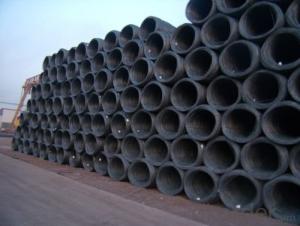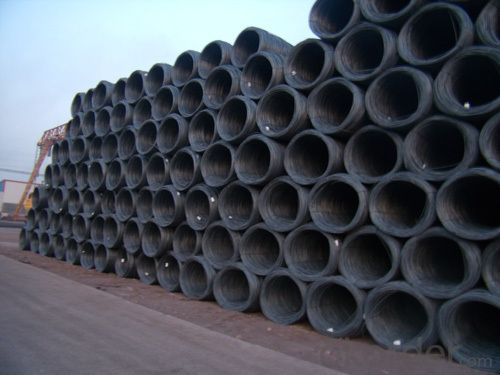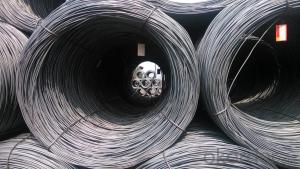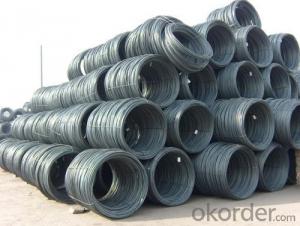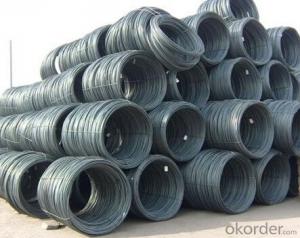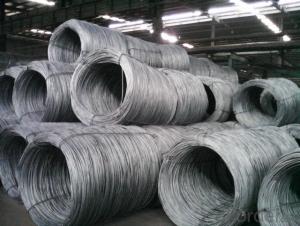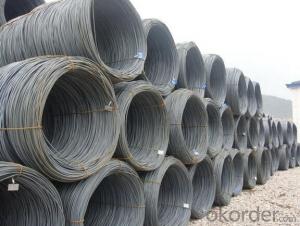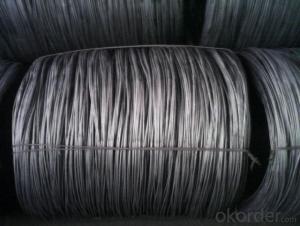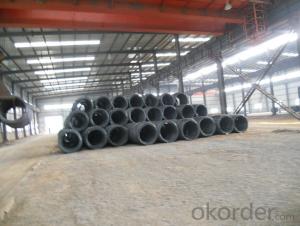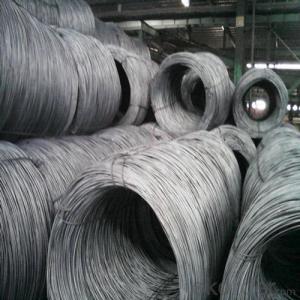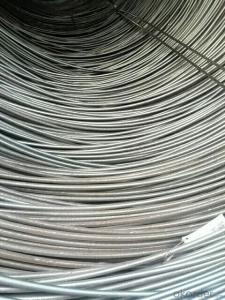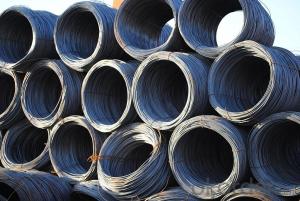Hot Rolled Mild Steel Wire Rod with Boron SAE1018
- Loading Port:
- China Main Port
- Payment Terms:
- TT OR LC
- Min Order Qty:
- -
- Supply Capability:
- -
OKorder Service Pledge
Quality Product, Order Online Tracking, Timely Delivery
OKorder Financial Service
Credit Rating, Credit Services, Credit Purchasing
You Might Also Like
Quick Details
Steel Grade:Q235,SAE1008,SAE1018
Standard:AISI, ASTM, BS, DIN, GB, JIS
Wire Gauge:5.5-14mm
Type:Drawn Wire
Application:Manufacturing
Alloy Or Not:Is Alloy
Model Number:5.5-14MM
Packaging & Delivery
| Packaging Details: | in bulk or as per customer's requirement |
|---|---|
| Delivery Detail: | 10-45 days after receipt of copy of L/C and advanced payment |
- Q: How is steel wire rod used in the production of wire mesh sieves?
- Wire mesh sieves require steel wire rod as an essential component. The wire rod undergoes various processes, such as drawing, annealing, and coating, to improve its strength and durability. Once prepared, the steel wire rod is fed into a wire drawing machine to reduce its diameter to the desired size. This ensures uniform thickness and a smooth surface, which is crucial for subsequent manufacturing steps. After drawing, the wire is annealed to increase flexibility and remove any residual stresses. This makes it easier to work with and less likely to break during production. Next, the wire is coated with zinc or PVC to enhance its resistance to corrosion. This protective layer acts as a barrier, prolonging the wire's lifespan and maintaining its structural integrity. The coated wire is then woven or welded to create the wire mesh sieve. Weaving involves interlacing the wires in a crisscross pattern, while welding involves fusing the wires at their intersections using heat and pressure. The resulting wire mesh sieve is a versatile and reliable tool used in various industries. It is commonly employed for particle size analysis, filtration, and sorting applications. The steel wire rod used in its production ensures it can withstand high pressures and abrasion, making it suitable for demanding environments. In conclusion, steel wire rod plays a crucial role in the manufacturing process of wire mesh sieves. It undergoes drawing, annealing, and coating before being woven or welded to create the final product. The resulting wire mesh sieve is a robust tool used in a wide range of industries for particle analysis and filtration purposes.
- Q: What are the different types of steel wire rod coatings used for increased strength?
- There are several different types of steel wire rod coatings that are commonly used to increase strength. These coatings are applied to the surface of the wire rod to enhance its mechanical properties and improve its overall performance. One common type of coating used for increased strength is zinc coating. Zinc coating, also known as galvanizing, involves immersing the wire rod in a bath of molten zinc. This process forms a protective layer of zinc on the surface of the wire rod, which provides excellent corrosion resistance. The zinc coating also acts as a barrier, preventing the wire rod from coming into direct contact with corrosive substances, thus increasing its strength and durability. Another type of coating used for increased strength is polymer coating. Polymer coatings are applied to the wire rod through various methods such as extrusion or electrostatic spraying. These coatings form a protective layer that offers resistance to abrasion, impact, and corrosion. Polymer coatings can also improve the wire rod's flexibility and resistance to fatigue, thereby increasing its overall strength. Additionally, epoxy coatings are commonly used for increased strength. Epoxy coatings, which consist of a mixture of resin and hardener, are applied to the wire rod's surface through a process called electrostatic deposition. These coatings provide excellent adhesion and chemical resistance, making the wire rod stronger and more resistant to corrosion. Furthermore, ceramic coatings are used to increase the strength of steel wire rods. Ceramic coatings are typically applied through thermal spraying techniques, where a ceramic material is heated and propelled onto the wire rod's surface. These coatings offer exceptional hardness, wear resistance, and high-temperature resistance, making the wire rod more robust and suitable for demanding applications. In summary, the different types of steel wire rod coatings used for increased strength include zinc coating, polymer coating, epoxy coating, and ceramic coating. Each of these coatings provides distinct advantages in terms of corrosion resistance, flexibility, adhesion, and wear resistance, ultimately enhancing the strength and durability of the wire rod.
- Q: What are the common impurities found in steel wire rod?
- The common impurities found in steel wire rod include sulfur, phosphorus, silicon, and carbon.
- Q: How is steel wire rod used in the manufacturing of wire rope thimbles?
- Steel wire rod is used in the manufacturing of wire rope thimbles by being shaped and formed into the desired size and shape of the thimble. The wire rod is first drawn through a series of dies to reduce its diameter and increase its strength. It is then bent and molded into the thimble shape, ensuring that it can securely hold the wire rope. Finally, the thimble is heat-treated and galvanized to enhance its durability and resistance to corrosion. Overall, steel wire rod is a crucial raw material in the production of wire rope thimbles, providing the strength and structural integrity necessary for their usage.
- Q: How does the quality of steel wire rod affect the performance of wire products?
- The performance of wire products is heavily influenced by the quality of the steel wire rod. The strength and durability of wire products directly depend on the quality of the steel wire rod. When high-quality steel wire rods are used, they are made from superior materials and undergo strict manufacturing processes. As a result, they have enhanced tensile strength and resistance to deformation. This ensures that wire products can bear heavy loads, tension, and stress without breaking or losing shape. On the other hand, low-quality steel wire rods are more prone to breakage, stretching, or bending under similar conditions. This compromises the performance of the wire products and can potentially lead to hazardous situations. The overall performance of wire products is also affected by the surface finish of the wire rod. Precise manufacturing techniques are used to achieve a smooth and uniform surface finish, which reduces friction and abrasion during the use of wire products. This not only extends their lifespan but also improves their functionality. In contrast, wire rods with poor surface finish may have rough or uneven surfaces, resulting in increased friction and wear. This can lead to premature degradation, decreased performance, and potential safety hazards. Additionally, the chemical composition of the steel wire rod has an impact on the corrosion resistance of wire products. High-quality wire rods are typically made from corrosion-resistant materials or have protective coatings, which prevent rust or corrosion over time. This is particularly important for wire products used in outdoor or moist environments where exposure to water, humidity, or chemicals may occur. Wire products made from low-quality wire rods with inadequate corrosion resistance can deteriorate faster, leading to decreased performance, structural weakness, and potential failure. To summarize, the quality of the steel wire rod directly affects the performance of wire products. Opting for higher quality wire rods ensures the production of stronger, more durable, and longer-lasting wire products. These products have enhanced resistance to deformation, improved surface finish, and better corrosion resistance. Investing in high-quality steel wire rods guarantees the production of wire products that meet performance standards, provide reliable functionality, and ensure user safety.
- Q: What are the different types of wire mesh for sieving made from steel wire rod?
- Steel wire rod is used to create various types of wire mesh for sieving. These include: 1. The most commonly used wire mesh for sieving is plain weave. It is created by weaving steel wire rods together in an over-and-under pattern, resulting in a square or rectangular mesh structure. Plain weave wire mesh is known for its simplicity and versatility. 2. Twill weave wire mesh is similar to plain weave, but the wires are interlaced diagonally, resulting in a tighter mesh structure. This type of wire mesh is often employed for fine sieving applications that require a higher level of precision. 3. Dutch weave wire mesh is made by weaving the wires in an over-and-under pattern, but with varying wire diameters for the warp and weft wires. This creates a mesh with smaller openings in one direction, which is ideal for separating fine particles. 4. Welded wire mesh is formed by welding the intersecting points of the steel wires together, resulting in a durable and robust mesh structure. It is commonly used for heavy-duty sieving applications, such as in construction or industrial settings. 5. Expanded metal mesh is produced by cutting and stretching a flat sheet of steel, creating a mesh with diamond-shaped openings. This type of wire mesh is known for its strength and rigidity, making it suitable for sieving applications that require high impact resistance. In conclusion, there is a wide range of wire mesh options made from steel wire rod for sieving purposes. The choice of wire mesh depends on factors such as particle size, desired precision, and the intended use of the sieved material.
- Q: What is the difference between hot rolled and cold drawn steel wire rod?
- Hot rolled and cold drawn steel wire rods are both used in various industries for different applications. The main difference between the two lies in the manufacturing process. Hot rolled steel wire rod is produced by heating a billet or ingot to a high temperature and then rolling it through a series of rollers to achieve the desired shape and dimensions. This process results in a larger diameter and a rougher surface finish. Hot rolled steel wire rods are commonly used in construction, automotive, and machinery applications where strength and durability are important. They are also more cost-effective than cold drawn wire rods. On the other hand, cold drawn steel wire rod is produced by pulling the hot rolled wire rod through a series of dies at room temperature. This process results in a smaller diameter and a smoother surface finish compared to hot rolled wire rods. Cold drawn wire rods are commonly used in applications where precision and a smooth surface finish are required, such as in the manufacturing of precision components, automotive parts, and electrical conductors. In summary, the main difference between hot rolled and cold drawn steel wire rods is the manufacturing process, which affects the diameter, surface finish, and application suitability. Hot rolled wire rods are larger in diameter with a rougher surface finish, while cold drawn wire rods are smaller in diameter with a smoother surface finish. The choice between the two depends on the specific requirements of the application in terms of strength, precision, and surface finish.
- Q: What are the main factors affecting the market investments of steel wire rod?
- Some of the main factors affecting the market investments of steel wire rod include supply and demand dynamics, global economic conditions, government policies and regulations, technological advancements, competition from alternative materials, and fluctuations in raw material prices. Additionally, factors such as infrastructure development, construction and manufacturing activities, and the overall health of industries that use steel wire rod also play a significant role in influencing market investments.
- Q: How does the yield strength of steel wire rod vary with different heat treatment processes?
- The yield strength of steel wire rod can exhibit significant variations depending on the heat treatment processes employed. Heat treatment involves controlled heating and cooling of metals to modify their physical and mechanical characteristics. In the case of steel wire rod, heat treatment can induce alterations in the material's microstructure, consequently impacting its yield strength. One commonly utilized heat treatment method for steel wire rod is referred to as annealing. This technique entails heating the rod to a specific temperature, typically surpassing its critical temperature, followed by gradual cooling. Annealing serves to alleviate internal stresses, refine the microstructure, and enhance the steel's ductility. Consequently, the yield strength of the wire rod generally decreases following annealing. Alternatively, another heat treatment process known as quenching and tempering can significantly augment the yield strength of steel wire rod. Quenching involves rapidly cooling the heated rod in a liquid medium, such as oil or water, to attain a hardened structure. This process results in the formation of martensite, a rigid and brittle phase within the steel. However, martensite is also highly stressed and prone to cracking, necessitating further heat treatment to enhance its toughness. This is accomplished through tempering, whereby the quenched material is subjected to a specific temperature and subsequently cooled once again. Tempering diminishes the internal stresses within the martensite, leading to the creation of a more stable microstructure characterized by improved toughness and heightened yield strength. In essence, the yield strength of steel wire rod can exhibit variability depending on the employed heat treatment methods. Annealing generally diminishes the yield strength by enhancing ductility, whereas quenching and tempering can substantially increase the yield strength by generating a harder and more robust microstructure. The selection of a heat treatment process is contingent upon the desired mechanical properties and intended application of the steel wire rod.
- Q: How is steel wire rod used in the manufacturing of wire forms for conveyor systems?
- Steel wire rod is used in the manufacturing of wire forms for conveyor systems by being shaped, cut, and bent into various forms such as hooks, rings, and clips. These wire forms are then integrated into the conveyor system to provide support, stability, and control for the movement of materials or products along the system. The high strength and durability of steel wire rod make it an ideal material choice for wire forms in conveyor systems, ensuring reliable and efficient operation.
Send your message to us
Hot Rolled Mild Steel Wire Rod with Boron SAE1018
- Loading Port:
- China Main Port
- Payment Terms:
- TT OR LC
- Min Order Qty:
- -
- Supply Capability:
- -
OKorder Service Pledge
Quality Product, Order Online Tracking, Timely Delivery
OKorder Financial Service
Credit Rating, Credit Services, Credit Purchasing
Similar products
Hot products
Hot Searches
Related keywords
